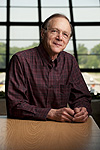Boris Kayser celebrates retirement
 |
|
Boris Kayser
|
Boris Kayser, one of Fermilab's experts on neutrino physics, will celebrate his retirement this Friday in the way that most people have come to appreciate him: explaining to both colleagues and the public how future experiments can solve scientists' questions about the perplexing behavior of neutrinos.
Kayser, who received his Ph.D. in physics at Caltech, worked for the National Science Foundation from 1972 to 2001, where he was the program director for theoretical physics. He spent his spare time doing research on weak neutral currents and became an expert on how neutrino interactions might be able to explain the dominance of matter over antimatter in the universe.
To truly enjoy his retirement from the NSF, Kayser decided to join Fermilab as a distinguished guest scientist! Although he had planned to focus on research, Kayser may have served on more committees and advisory panels during his 12 years at Fermilab than most scientists during their entire lifetime. He served on the Particle Physics Prioritization Panel (2002-2007), the Fermilab Physics Advisiory Committee (2004-2008), the NuSAG (2005-2007) and PAC DUSEL (2010-present). He was elected chair of the Division of Particles and Fields of the American Physical Society (2009). His legacy also includes the startup of a neutrino school for graduate students and postdocs.
"Boris has been instrumental in defining the future neutrino program at Fermilab," said Stephen Parke, head of the Fermilab Theory Department. "It's been great having him around to bounce off new ideas in neutrino physics."
Kayser, who officially retired at the end of 2012, will remain a frequent guest at Fermilab. Freed from his day-to-day work duties, he is writing a book about neutrino physics, will continue to do more research and travel around the world.
Please join Kayser at his "wine and cheese" seminar this Friday, Nov. 22, at 4 p.m. in One West.
—Kurt Riesselmann
|